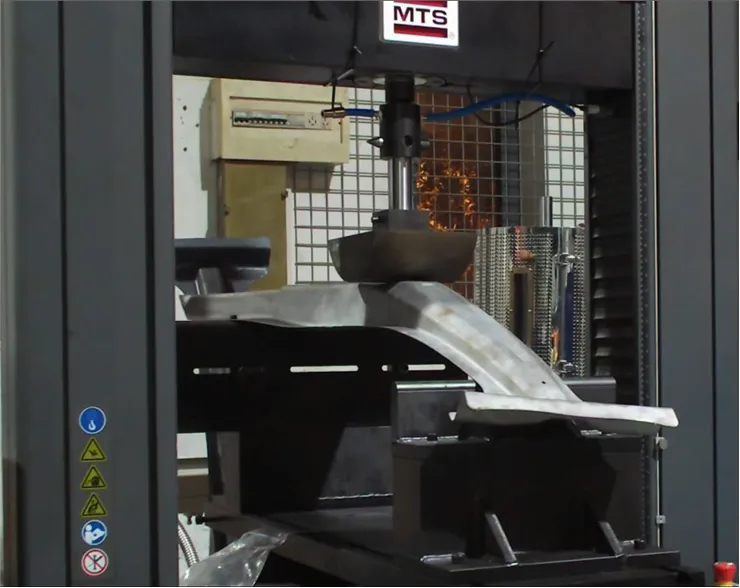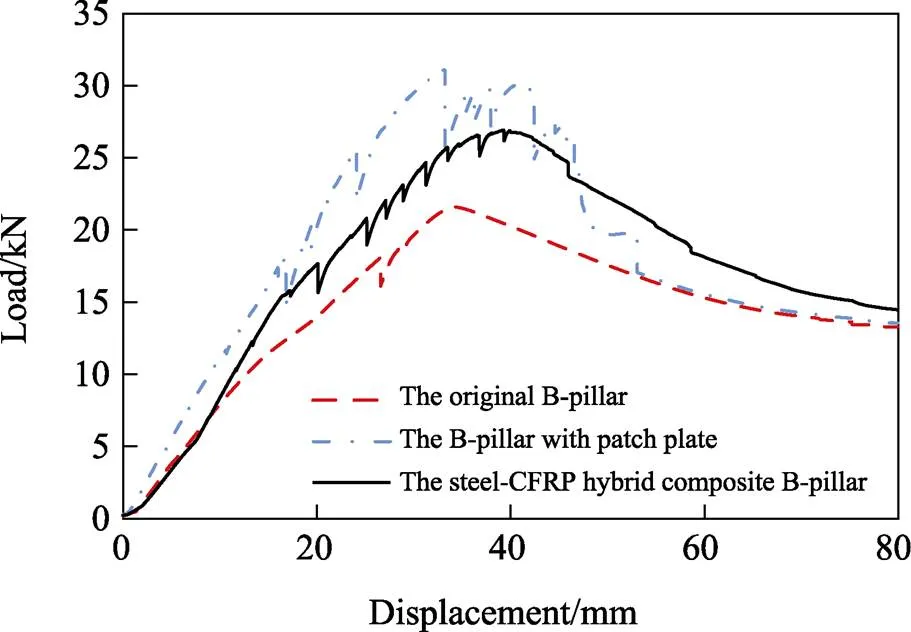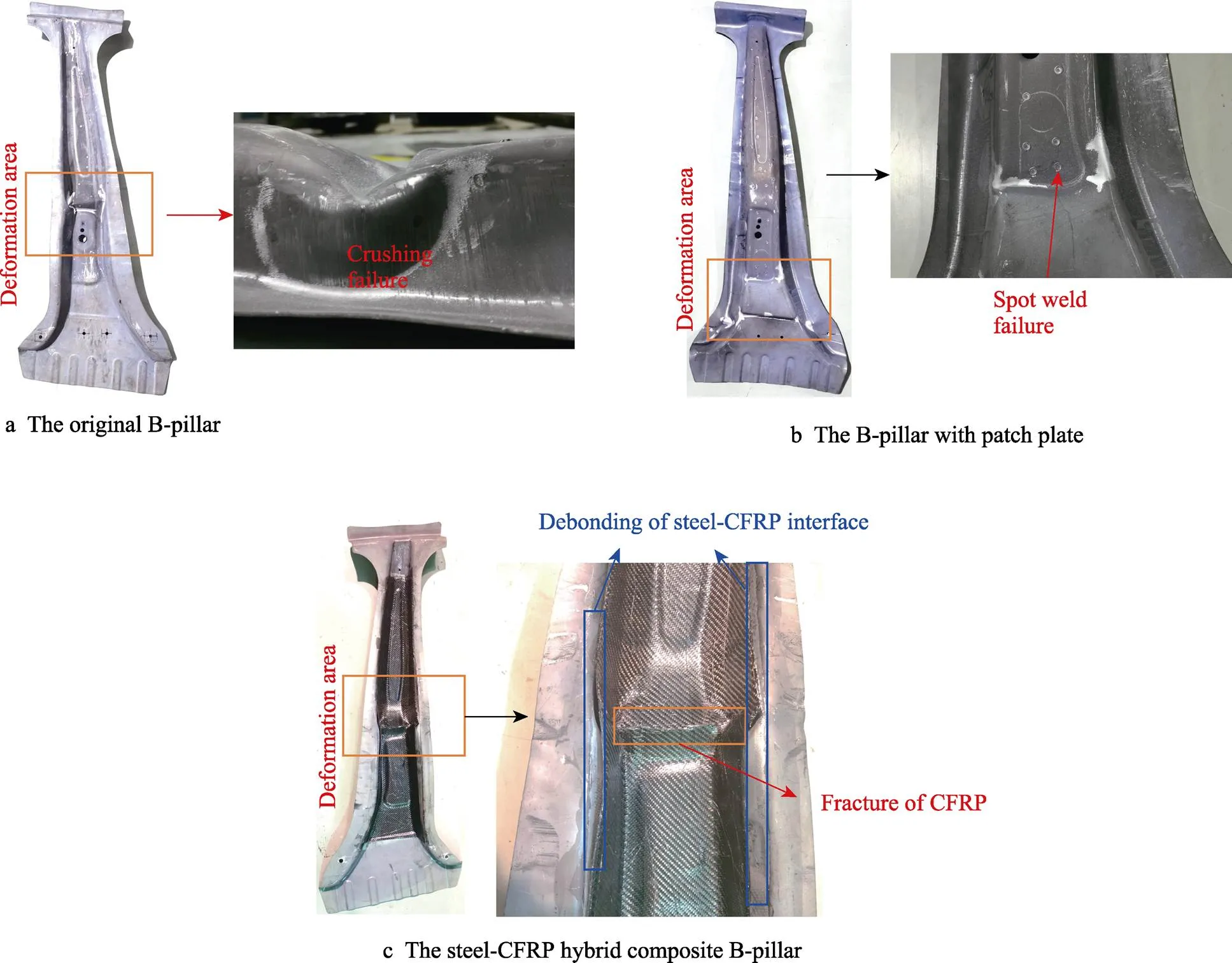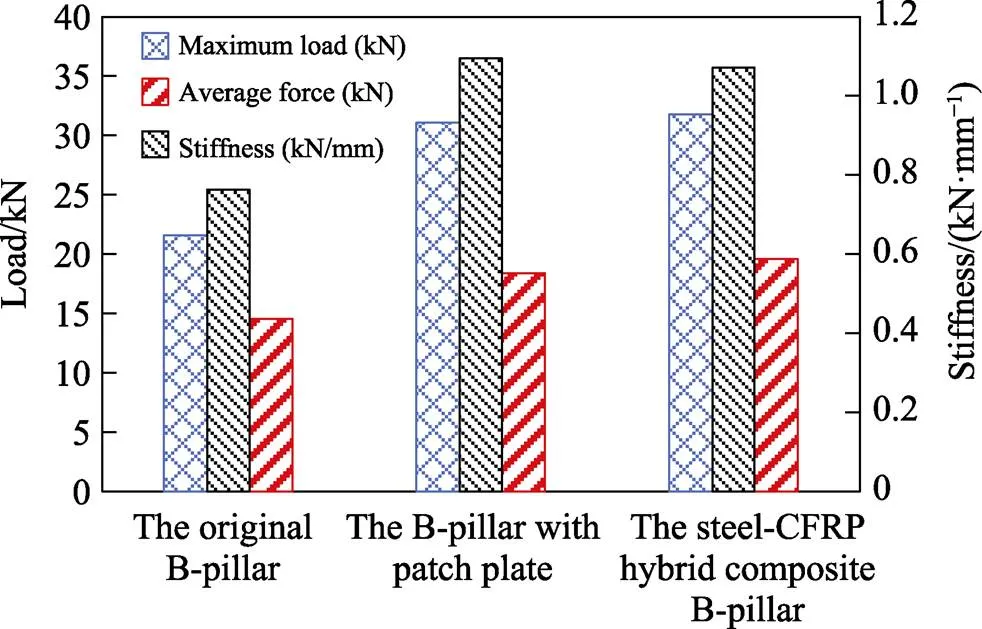钢‒CFRP异质复合B柱的弯曲实验分析
2023-02-03马治军黄朝阳滕昊林建平
马治军,黄朝阳,滕昊,林建平
复合材料成形
钢‒CFRP异质复合B柱的弯曲实验分析
马治军1,黄朝阳1,滕昊2,林建平2
(1.上海赛科利汽车模具技术应用有限公司,上海 202106;2.同济大学 机械与能源工程学院,上海 200092)
为提高B柱的抗弯性能,通常会在B柱上额外焊接补丁板,但同时也增加了B柱的重量。在原始B柱上铺设碳纤维增强复合材料(CFRP),获得钢‒CFRP异质复合B柱,取消B柱的钢制加强板,实现B柱的轻量化。通过热冲压制备原始B柱及带补丁板B柱,并以原始B柱为凹模,采用真空袋压工艺制备钢‒CFRP异质复合B柱。基于2018版C‒NCAP侧面碰撞实验要求,设计B柱三点弯曲夹具,进行原始B柱、带补丁板B柱及钢‒CFRP异质复合B柱的三点弯曲实验,并对其重量及弯曲性能进行分析。原始B柱重量4.1 kg,三点弯曲实验测得其刚度为0.763 kN/mm,最大载荷为21.59 kN,平均力为14.52 kN;带补丁板B柱质量为5.6 kg,三点弯曲实验测得其刚度为1.095 kN/mm,最大载荷为31.08 kN,平均力为18.38 kN;钢‒CFRP异质复合B柱总质量4.7 kg,三点弯曲试验测得其刚度为1.071 kN/mm,最大载荷为31.76 kN,平均力为19.58 kN。在保持刚度、最大载荷及平均力等弯曲力学性能不变的前提下,相对于带补丁板B柱,钢‒CFRP异质复合B柱可以减轻质量0.9 kg,并且吸能更优,实现了B柱的轻量化。
碳纤维增强复合材料;真空袋压工艺;钢‒CFRP异质复合B柱;三点弯曲;轻量化
金属-碳纤维增强复合材料(Carbon Fiber Reinforced Plastic,CFRP)异质复合构件将金属与CFRP连接后一起进行承载,可提高构件的拉伸、弯曲、抗冲击等力学性能[1-5],进而助力实现零件的轻量化设计。根据金属和CFRP成形先后顺序及连接方式,目前金属-CFRP异质复合结构成形工艺路线可以分为4类:金属和CFRP分别制造成形后,再采用胶、铆、焊等手段进行连接[6-9];金属零件成形后,以金属零件为模,同时进行CFRP成形及金属和CFRP的连接[10-11];金属和CFRP同步成形并实现连接[12-13];先将金属和CFRP采用热压或热压罐成形等工艺制备成金属‒CFRP异质复合板,再采用其他成形工艺制备为需要的形状[14-17]。
金属-FRP异质构件被广泛应用于航空领域及汽车领域,如机翼、机身蒙皮、车身等[18-21]。2015年,宝马公司首先在其7系车上应用了金属-CFRP异质复合构件,如车顶横梁、B柱、C柱、门槛梁及中央通道上,使整车重量减轻了130 kg[22]。陆冉[23]基于成形加胶接的成形工艺制造了钢-CFRP异质复合B柱,对制造的CFRP B柱补丁板进行了三点弯曲仿真与实验,在刚度不变情况下,实现了补丁板质量减轻31%。熊长丽[24]先采用单向碳纤维布和树脂传递模塑工艺制造了CFRP补丁板,再将补丁板和钢质B柱胶粘在一起,在总刚度不变的情况下,补丁板减重70%。
文中以某汽车带补丁板B柱为研究对象,在保持刚度、强度、平均力等指标不变的情况下,以钢制B柱构件为模,制作了钢-CFRP异质复合B柱,并通过三点弯曲实验与分析,为钢-CFRP异质复合B柱的应用提供技术参考。
1 钢-CFRP异质复合B柱的成形工艺与三点弯曲实验
1.1 钢-CFRP异质复合B柱的真空袋压成形制造
本研究中的钢-CFRP异质复合B柱是在已经成形的原始B柱上铺设碳纤维增强复合材料,采用真空袋压工艺制成。具体成形制造工艺流程:采用热冲压成形工艺制备原始B柱;对钢板进行表面处理,主要目的是提高钢与CFRP之间的结合性能,故对钢板表面进行喷砂处理;在原加强板位置铺设复合材料预浸料,共铺设5层12K双向预浸料,其单向拉伸强度为983 MPa;将铺设好CFRP预浸料的B柱依次用隔离膜、透气毡、真空袋等进行包裹;将真空袋打包好的钢-CFRP异质复合B柱放进热压罐中,并通过真空快速接头与真空泵连接,固化成形,完成钢- CFRP异质复合B柱的制作。
1.2 钢-CFRP异质复合B柱三点弯曲实验
根据2018版C-NCAP侧面碰撞实验要求[25],研究设计了三点弯曲夹具。其中,冲头半径为125 mm,2个支撑脚架半径为10 mm,如图1所示。B柱根据侧面碰撞实验中冲击位置放置于2个支撑上,三点弯曲实验在MTS万能实验机上进行,冲头下压速率为15 mm/min。实验在室温下共进行3组,分别是原始B柱(无补丁板)、带补丁板B柱及钢-CFRP异质复合B柱。以冲头与B柱接触开始的时刻为实验起始点,冲头下压80 mm时实验停止。

图1 B柱三点弯曲实验
2 钢-CFRP异质复合B柱三点弯曲实验结果与分析
在MTS万能实验机上获得B柱三点弯曲实验的载荷-位移曲线,如图2所示,各个B柱的失效形式如图3所示,可见原始B柱(无补丁板)的失效形式为压溃失效;带补丁板的B柱主要失效形式为补丁板焊点失效之后的压溃失效;钢-CFRP异质复合B柱没有出现整体CFRP脱粘的现象,主要的失效形式为中间位置CFRP的断裂及断裂处附近界面脱粘,表明真空袋压工艺可以较好实现CFRP的成形与钢‒CFRP界面的连接。

图2 B柱三点弯曲实验的载荷-位移曲线
由图2可知,当冲头位移小于9.8 mm时,原始B柱和钢-CFRP异质复合B柱的承载小于带补丁板B柱;当冲头加载到14.5 mm左右时,钢-CFRP异质复合B柱的载荷已经达到了补丁板B柱的强度;当冲头加载到16.9 mm时,由于发生了焊点失效,补丁板B柱载荷出现突然下降,随着载荷增大,越来越多焊点出现失效;钢-CFRP异质复合B柱在冲头分别加载到20.2 mm时,CFRP开始断裂,载荷出现突然下降;原始B柱、带补丁板B柱和钢‒CFRP异质复合B柱分别在冲头加载到34.5、33.8、40.1 mm处时载荷达到峰值。此外,钢‒CFRP异质复合B柱达到峰值后,其对抗侵入量与吸能效应明显优于带补丁板B柱。
所有B柱的刚度、最大载荷、平均力的具体数值如表1和图4所示。通过补丁板和CFRP对钢板进行补强,均可提高B柱的刚度、最大载荷、平均力等指标,但两者增强方式存在一定区别。钢-CFRP异质复合B柱质量相对于带补丁板B柱减少了0.9 kg,刚度、最大载荷、平均力分别达到了带补丁板B柱的98%、102%、107%,表明钢-CFRP异质复合B柱吸能效果优于带补丁板B柱,实现了B柱的轻量化设计。

图3 B柱失效图
表1 B柱力学性能对比

Tab.1 Comparison of mechanical properties of B-pillar

图4 B柱力学性能对比
3 结论
通过CFRP替代钢制补丁板,实现了B柱轻量化设计。基于2018版C-NCAP侧面碰撞实验要求设计了B柱三点弯曲夹具,并进行了原始B柱、带补丁板B柱及钢‒CFRP异质复合B柱的三点弯曲实验,通过对比各个B柱的质量、刚度、最大载荷、平均力,可以得出以下主要结论。
1)通过真空袋压工艺可较好地同时实现CFRP成形与钢-CFRP的界面连接。
2)在保持刚度、最大载荷及平均力等弯曲力学性能不变的前提下,钢-CFRP异质复合B柱相对带补丁板B柱可以减轻质量0.9 kg,实现B柱的轻量化。
[1] VASUDEVAN A, KUMAR B N, Depoures M V, et al. Tensile and Flexural Behaviour of Glass Fibre Reinforced Plastic - Aluminium Hybrid Laminate Manufactured by Vacuum Resin Transfer Moulding Technique (VARTM)[J]. Materials Today: Proceedings, 2021, 37: 2132-2140.
[2] ZHENG Zi-han, DU Yan-sheng, CHEN Zhi-hua, et al. Experimental and Theoretical Studies of FRP-Steel Composite Plate under Static Tensile Loading[J]. Construction and Building Materials, 2021, 271: 121501.
[3] DHALIWAL G S, NEWAZ G M. Experimental and Numerical Investigation of Flexural Behavior of Carbon Fiber Reinforced Aluminum Laminates[J]. Journal of Reinforced Plastics and Composites, 2016, 35(12): 945-956.
[4] YAO Lu, SUN Guang-yong, HE Wen-tao. Investigation on Impact Behavior of FMLS under Multiple Impacts with the Same Total Energy: Experimental Characterization and Numerical Simulation[J]. Composite Structures, 2019, 226: 111218.
[5] TAHERZADEH-FARD A, LIAGHAT G, AHMADI H, et al. Experimental and Numerical Investigation of the Impact Response of Elastomer Layered Fiber Metal Laminates (EFMLs)[J]. Composite Structures, 2020, 245: 112264.
[6] WANG Zhen, LI Cheng-gao, SUI Li-li, et al. Effects of Adhesive Property and Thickness on the Bond Performance between Carbon Fiber Reinforced Polymer Laminate and Steel[J]. Thin-Walled Structures, 2021, 158: 107176.
[7] RAO H M, KANG Ji-dong, HUFF G, et al. Impact of Specimen Configuration on Fatigue Properties of Self-Piercing Riveted Aluminum to Carbon Fiber Reinforced Polymer Composite[J]. International Journal of Fatigue, 2018, 113: 11-22.
[8] NAGATSUKA K, XIAO B, WU L, et al. Dissimilar Materials Joining of Metal/Carbon Fibre Reinforced Plastic by Resistance Spot Welding[J]. Welding International, 2018, 32(7): 505-512.
[9] 蒋浩, 廖宇轩, 李光耀, 等. 碳纤维-铝合金电磁铆接工艺及性能研究[J]. 精密成形工程, 2021, 13(4): 37-44.
JIANG Hao, LIAO Yu-xuan, LI Guang-yao, et al. Study on Process and Mechanical Properties of CFRP/Al Electromagnetic Riveted Structures[J]. Journal of Netshape Forming Engineering, 2021, 13(4): 37-44.
[10] ALABTAH F G, MAHDI E. The Effect of Sizing Optimization on the Interface between High Strength Steel and Fiber Reinforced Composite[J]. Composite Structures, 2021, 266: 113740.
[11] TAYLOR T, PENNEY D, YANAGIMOTO J. One-Step Process for Press Hardened Steel-Carbon Fiber Reinforced Thermoset Polymer Hybrid Parts[J]. Steel Research International, 2020, 91(10): 2000085.
[12] GUO Yu-qin, ZHAI Chang-pan, LI Fu-zhu, et al. Formability, Defects and Strengthening Effect of Steel/CFRP Structures Fabricated by Using the Differential Temperature Forming Process[J]. Composite Structures, 2019, 216: 32-38.
[13] MENNECART T, HIEGEMANN L, KHALIFA N B. Analysis of the Forming Behaviour of In-Situ Drawn Sandwich Sheets[J]. Procedia Engineering, 2017, 207: 890-895.
[14] SINKE J. Forming Technology for Composite/Metal Hybrids[M]// Composites Forming Technologies. Amsterdam: Elsevier, 2007: 197-219.
[15] RUSSIG C, BAMBACH M, HIRT G, et al. Shot Peen Forming of Fiber Metal Laminates on the Example of GLARE®[J]. International Journal of Material Forming, 2014, 7(4): 425-438.
[16] CAREY C, CANTWELL W J, DEARDEN G, et al. Towards a Rapid, Non-Contact Shaping Method for Fibre Metal Laminates Using a Laser Source[J]. The International Journal of Advanced Manufacturing Technology, 2010, 47(5): 557-565.
[17] 韩奇钢, 孙延标, 杨文珂, 等. 纤维/金属层状复合材料的研究及应用进展[J]. 精密成形工程, 2019, 11(1): 17-24.
HAN Qi-gang, SUN Yan-biao, YANG Wen-ke, et al. The Development in Research and Application of Fiber Metal Laminated Composites[J]. Journal of Netshape Forming Engineering, 2019, 11(1): 17-24.
[18] CHEN Yi-zhe, WANG Yi-chun, WANG Hui. Research Progress on Interlaminar Failure Behavior of Fiber Metal Laminates[J]. Advances in Polymer Technology, 2020, 2020: 1-20.
[19] VLOT A, GUNNINK J W. Fibre Metal Laminates: An Introduction[M]. Dordrecht: Kluwer Academic Publishers, 2001.
[20] ALDERLIESTEN R. On the Development of Hybrid Material Concepts for Aircraft Structures[J]. Recent Patents on Engineering, 2009, 3(1): 25-38.
[21] BÖTTCHER A, OPDEMOM H. Series-Production Adhesive Process for Hybrid Components[J]. Lightweight Design Worldwide, 2019, 12(6): 48-53.
[22] NICO D M. BMW 7 Series' Carbon Core more important that you might think[EB/OL]. (2015-09-01) [2021-07-01].https://www.bmwblog.com/2015/09/01/bmw-7-series-carbon-core-more-important-that-you-might-think/.
[23] 陆冉. 面向轻量化的CFRP汽车B柱逆向设计与仿真分析[D]. 扬州: 扬州大学, 2020: 56-66.
LU Ran. Reverse Design and Simulation Analysis for Lightweight CFRP Vehicle B-Column[D]. Yangzhou: Yangzhou University, 2020: 56-66.
[24] 熊长丽. 碳纤维复合材料汽车B柱加强板的轻量化设计研究[D]. 长春: 吉林大学, 2018: 54-57.
XIONG Chang-li. Study on Lightweight Design of Automotive B-Pillar Reinforced Plate with Carbon Fiber Reinforced Plastic Material[D]. Changchun: Jilin University, 2018: 54-57.
[25] C‒NCAP 管理规则[S]. 天津:中国汽车技术研究中心有限公司, 2018.
C-NCAP Management Regulation Official[S]. Tianjin: China Automotive Technology & Research Center Co., Ltd., 2018.
Bending Test Analysis of Steel-CFRP Hybrid Composite B-Pillar
MA Zhi-jun1, HUANG Zhao-yang1, TENG Hao2, LIN Jian-ping2
(1. Shanghai Superior Die Technology Co., Ltd., Shanghai 202106, China; 2. College of Mechanical Engineering, Tongji University, Shanghai 200092, China)
In order to improve the bending resistance of B-pillar, additional patch plates are usually welded to the B-pillar, which increases the weight of the B-pillar at the same time. The work aims to lay carbon fiber reinforced composite (CFRP) on the original B-pillar to obtain the steel-CFRP hybrid composite B-pillar, and eliminate the steel reinforced plate to realize the lightweight of B-pillar.The original B-pillar and B-pillar with patch plate were prepared by hot stamping. The steel-CFRP hybrid composite B-pillar was fabricated by vacuum bag pressure molding with the original B-pillar as the die. Based on the requirements of C-NCAP side impact test (2018 Edition), a three-point bending fixture for B-pillar was designed, and three-point bending test was carried out to original B-pillar, B-pillar with patch plate and steel-CFRP hybrid composite B-pillar. The original B-pillar had the weight of 4.1 kg, stiffness of 0.763 kN/mm measured by three-point bending test, maximum load of 21.59 kN and average force of 14.52 kN. The B-pillar with patch plate had the weight of 5.6 kg, stiffness of 1.095 kN/mm measured by three-point bending test, maximum load of 31.08 kN and average force of 18.38 kN. The steel-CFRP hybrid composite B-pillar had the total weight of 4.7 kg, stiffness of 1.071 kN/mm measured by three-point bending test, maximum load of 31.76 kN and average force of 19.58 kN. Under the premise of maintaining the bending mechanical properties such as stiffness, maximum load and average force, the weight of steel-CFRP hybrid B-pillar can be reduced by 0.9 kg compared with that of B-pillar with patch plate, and the energy absorption is better, which realizes the lightweight design of B-pillar.
carbon fiber reinforced plastic; vacuum bag pressure molding; steel-CFRP hybrid composite B-pillar; three-point bending; lightweight
10.3969/j.issn.1674-6457.2023.01.013
TD406
A
1674-6457(2023)01-0101-05
2022‒01‒17
2022-01-17
马治军(1988—),男,博士,主要研究方向为热成形钢工艺及其轻量化。
MA Zhi-jun (1988-), Male, Doctor, Research focus: hot forming steel process and its lightweight.
滕昊(1996—),男,博士研究生,主要研究方向为钢‒CFRP异质复合构件力学性能及界面结合性能。
TENG Hao (1996-), Male, Doctoral candidate, Research focus: mechanical properties and interface bonding properties of steel-CFRP hybrid composite structures.
马治军, 黄朝阳, 滕昊, 等. 钢‒CFRP异质复合B柱的弯曲实验分析[J]. 精密成形工程, 2023, 15(1): 101-105.
MA Zhi-jun, HUANG Zhao-yang, TENG Hao, et al. Bending Test Analysis of Steel-CFRP Hybrid Composite B-Pillar[J]. Journal of Netshape Forming Engineering, 2023, 15(1): 101-105.
